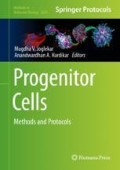Abstract
The urothelium of the bladder and urethra are derived from the definitive endoderm during development. Cellular signaling molecules important to the developmental specification of the urothelium are also implicated in the dysregulation of the tissue repair mechanism characteristic of bladder disease. Hence, a complete understanding of the regulation of urothelium development is central to understanding the processes of bladder disease, and in development of simple chemically defined methods for use in regenerative medicine. Key to this is a suitable in vitro model that readily allows for the prosecution of biologically pertinent questions. Here a method for differentiating urothelium from mouse embryonic stem cells in chemically defined conditions is described. The method includes a description of flow cytometry and RT-PCR analysis of definitive endoderm markers Cxcr4, c-Kit, and FoxA2, and of terminally differentiated urothelial cell markers Upk1b and Upk2.
Access this chapter
Tax calculation will be finalised at checkout
Purchases are for personal use only
References
Hicks RM (1975) The mammalian urinary bladder: an accommodating organ. Biol Rev 50:215–246
Hicks RM, Ketterer B, Warren RC (1974) The ultrastructure and chemistry of the luminal plasma membrane of the mammalian urinary bladder: a structure with low permeability to water and ions. Philos Trans R Soc Lond Ser B Biol Sci 268:23–38
Visnjar T, Kocbeck P, Kreft ME (2012) Hyperplasia as a mechanism for rapid resealing urothelial injuries and maintaining high transepithelial resistance. Histochem Cell Biol 137:177–186
Sun TT, Zhao H, Provet J, Aebi U, Wu XR (1996) Formation of asymmetric unit membrane during urothelial differentiation. Mol Biol Rep 23:3–11
Wu XR, Kong XP, Pellicer A, Kreibech G, Sun TT (2009) Uroplakins in urothelial biology, function and disease. Kidney Int 75:1153–1165
Colopy SA, Bjorling DE, Mulligan WA, Bushman W (2014) A population of progenitor cells in the basal and intermediate layers of the murine bladder urothelium contributes to urothelial development and regeneration. Dev Dyn 243:988–998
Wang C, Ross WT, Myosorekar IU (2017) Urothelial generation and regeneration in development, injury and cancer. Dev Dyn 246:336–343
Mysorekar IU, Mulvey MA, Hultgren SJ, Gordon JI (2002) Molecular regulation of urothelial renewal and host defenses during infection with uropathogenic Escherichia coli. J Biol Chem 277:7412–7419
Dasgupta J, Tincello DG (2009) Interstitial cystitis/bladder pain syndrome: an update. Maturitas 64:212–217
Kaufman DS, Shipley WU, Feldman AS (2009) Bladder cancer. Lancet 374:239–249
Keller J, Chiou H-Y, Lin H-C (2013) Increased risk of bladder cancer following diagnosis with bladder pain syndrome/interstitial cystitis. Neurourol Urodyn 32:58–62
Khandelwal P, Abraham SN, Apodaca G (2009) Cell biology and physiology of the uroepithelium. Am J Physiol Renal Physiol 297:F1477–F1501
Boumelhem BB, Assinder SJ, Hammans C, Tanudiastro MP, Le DTM, Brigden KWL, Fraser ST (2017) The mesendoderm: a wellspring of cell lineages for regenerative medicine. In: Frontiers in stem cell and regenerative medicine research, vol 4. Bentham Science Publishers, Sharjah, pp 3–67
Gupta A, Bischoff A, Peña A et al (2014) The great divide: septation and malformation of the cloaca, and its implications for surgeons. Pediatr Surg Int 30:1089–1095
Marker PC, Donjacour AA, Dahiya R et al (2003a) Hormonal, cellular, and molecular control of prostatic development. Dev Biol 253:165–174
Cao M, Liu B, Cunha G et al (2008) Urothelium patterns bladder smooth muscle location. Pediatr Res 64:352–357
Haraguchi R, Motoyama J, Sasaki H, Satoh Y, Miyagawa S, Nakagata N, Moon A, Yamada G (2007) Molecular analysis of coordinated bladder and urogenital organ formation by hedgehog signalling. Development 134:525–533
Cunha GR, Fujii H, Neubauer BL et al (1983) Epithelial-mesenchymal interaction in prostatic development. I. Morphological observations of prostatic induction by urogenital sinus mesenchyme in epithelium of the adult rodent urinary bladder. J Cell Biol 96:1662–1670
Chung LW, Cunha GR (1983) Stromal-epithelial interactions: II. Regulation of prostatic growth by embryonic urogenital sinus mesenchyme. Prostate 4:503–511
Tanaka ST, Ishii K, Demarco RT et al (2010) Endodermal origin of bladder trigone inferred from mesenchymal-epithelial interaction. J Urol 183:386–391
Li W, Cavasotto CN, Cardozo T et al (2005) Androgen receptor mutations identified in prostate cancer and androgen insensitivity syndrome display aberrant ART-27 coactivator function. Mol Endocrinol 19:2273–2282
Wu X-R, Kong X-P, Pellicer A et al (2009) Uroplakins in urothelial biology, function, and disease. Kidney Int 75:1153–1165
Moll R, Wu XR, Lin JH et al (1995) Uroplakins, specific membrane proteins of urothelial umbrella cells, as histological markers of metastatic transitional cell carcinomas. Am J Pathol 147:1383–1397
Mauney JR, Ramachandran A, Yu RN et al (2010) All-trans retinoic acid directs urothelial specification of murine embryonic stem cells via GATA4/6 signaling mechanisms. PLoS One 5:e11513
Kang M, Kim H, Han Y-M (2014) Generation of bladder urothelium from human pluripotent stem cells under chemically defined serum- and feeder-free system. Int J Mol Sci 15:7139–7157
Osborn SL, Thangappan R, Luria A et al (2014) Induction of human embryonic and induced pluripotent stem cells into urothelium. Stem Cells Transl Med 3:610–619
Soprano DR, Teets BW, Soprano KJ (2007) Role of retinoic acid in the differentiation of embryonal carcinoma and embryonic stem cells. Vitam Horm 75:69–95
Oottamasathien SS, Wang YY, Franco WKK et al (2007) Directed differentiation of embryonic stem cells into bladder tissue. Dev Biol 304:11–11
D'Amour KA, Agulnick AD, Eliazer S (2005) Efficient differentiation of human embryonic stem cells to definitive endoderm. Nat Biotechnol 23:1534–1541
Christodoulou C, Longmire TA, Shen SS (2011) Mouse ES and iPS cells can form similar definitive endoderm despite differences in imprinted genes. J Clin Invest 121:2313–2325
Author information
Authors and Affiliations
Corresponding author
Editor information
Editors and Affiliations
Rights and permissions
Copyright information
© 2019 Springer Science+Business Media, LLC, part of Springer Nature
About this protocol
Cite this protocol
Boumelhem, B.B., Fraser, S.T., Assinder, S.J. (2019). Differentiation of Urothelium from Mouse Embryonic Stem Cells in Chemically Defined Conditions. In: Joglekar, M., Hardikar, A. (eds) Progenitor Cells. Methods in Molecular Biology, vol 2029. Humana, New York, NY. https://doi.org/10.1007/978-1-4939-9631-5_9
Download citation
DOI: https://doi.org/10.1007/978-1-4939-9631-5_9
Published:
Publisher Name: Humana, New York, NY
Print ISBN: 978-1-4939-9630-8
Online ISBN: 978-1-4939-9631-5
eBook Packages: Springer Protocols

